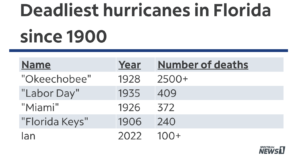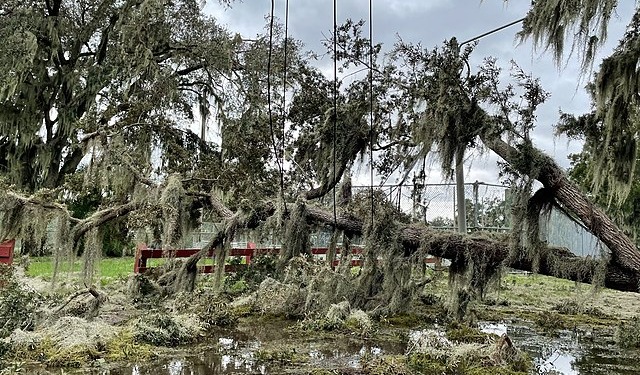A little over a week ago, the category four Hurricane Ian hit the coast of Florida, wreaking havoc throughout the state and killing at least 72.
By nightfall on the day, two million residents were without power in the state and winds had reached a maximum of 150 mph — eventually slowing down to 90 mph when the hurricane dropped to a category one.
The full effects of the devastating event are now becoming more apparent, with the death toll now reaching an absurd high.
Deadliest since 1935
State authorities have documented 72 deaths so far, but county sheriff reports point to a death toll of 103. In either case, the number of deaths has surpassed previously devastating hurricanes such as Hurricane Andrew in 1992 where 65 people were killed.
The most destructive hurricane in Florida history was Hurricane Okeechobee in 1928, which killed 2,500 people followed by the Labor Day Hurricane in 1935 which killed 409 people. A chart by Spectrum News 1 shows Hurricane Ian as one of the top five deadliest hurricanes in Florida.

According to Florida’s Medical Examiners Commission, slightly more than half of the victims of Ian drowned. The National Hurricane Center reports that storm surges, rainfall, inland flooding, and surf, contribute to 90% of hurricane deaths in the United States.
Many of the victims were trapped inside their homes or swept away by the current — water which had reached 18 feet. Many of those who died were elderly.
As the rescue teams continue to look for survivors, relying on cadaver dogs to sniff human scents, authorities are debating what constitutes a death as a hurricane death.
Deaths being debated are that of someone who committed sucide during the storm and another who died of a heart attack. Florida’s Medical Examiners Commission believes these deaths could constitute as hurricane deaths — reasoning that if medical services weren’t down, the heart attack could’ve been preventable.
A tainted water supply
The hurricane has also lead to the contamination of Florida’s water supply by sewage, oil and other harmful substances.
There are already reports of sewage and gasoline leaks from submerged vehicles and decomposing trees in the water, which had fallen down during the storm. The storm could also have leaked pesticides and herbicides from farms and yards into the ocean.
Dave Tomasko, director of the Sarasota Bay Estuary Program, said he had received dozens of notifications of wastewater treatment overflows since Hurricane Ian hit. On Tuesday, residents were notified to limit their water usage because of overflowing sewers in the area.
The storm’s excessive winds and rainfall washed leaves, organic matter and contaminants into the waterways across Florida, promising serious environmental consequences; researchers are now saying the water quality could damage ecosystems for weeks, months or even years.
Images from the International Space Station, shown in the tweet below, illustrate the extent of the water runoff on the coast of Florida.
Here is the @Space_Station's view of Florida from the @City_of_KeyWest to the @CityofMiami, with some extraordinary views of #Ian runoff on the gulf side. Captured live at 12:37pm EDT today@NWSKeyWest @NWSMiami @wsvn @nbc6 @WPLGLocal10 @CBSMiami
Oct 3, 2022 pic.twitter.com/Wa86wIlcUH— ISS Above (@ISSAboveYou) October 3, 2022
Satellite images show an excess of water runoff, including soil and overflowing rivers, emptying into the ocean near the coast of Florida.
A brown discoloration is seen in images of the coast, the brown water being a substance called tannins — a dissolved organic matter that floats to the top of water. Other discoloration like turquoise water could be organic matter and sediment from the hurricane.
Organic matter in the ocean is dangerous as too much of it can have serious repercussions on the ecosystem, blocking sunlight from plants deep in the ocean and decreasing their ability to make food from photosynthesis — which will evidently lead to the their deaths.
Microbes from the organic matter also consume high amounts of oxygen, which many fish and plants depend on.
One plant of particular concern is Florida’s tall seagrass, which helps prevent erosion, maintain water clarity by trapping sediment and provides food for animals. However, the plant also requires a lot of sunlight — the current conditions of Florida’s water proving dangerous to the plant’s survival.
As of now, no one knows when water will be fully restored to Florida. Tomasko pointed out the effects on water quality are some of the worst in the state’s history, more so than those of Hurricane Charley in 2004, the last category 4 hurricane to hit the western coast of Florida.
Biden calls Hurricane Ian a cause of climate change
On Wednesday, President Joe Biden visited Fort Myers Wednesday, the area most affected by the Hurricane. Both Florida Republican Governor Ron DeSantis and Biden united together to comfort the state amid mass destruction — despite the fact DeSantis is said to be running against Biden in the 2024 election.
In his address, Biden pointed to climate change as the main reason for Hurricane Ian’s mass destruction and connected the last climate disaster to others currently happening across the nation.
“More fires have burned in the west and the south-west, burned everything right to the ground, than in the entire state of New Jersey, as much room as that takes up,” said Biden. “The reservoirs out west here are down to almost zero. We’re in a situation where the Colorado River looks more like a stream.”
On the contrary, DeSantis has previously avoided using the term “climate change”’ — ironic considering his state could be seen as most affected by climate change related events such as hurricanes.
Despite his political beliefs in the denial of climate change, DeSantis thanked the president and his wife, First Lady Jill Biden, for coming down and showing their support. The governor also thanked Deanne Criswell, the Federal Emergency Management Agency (FEMA) administrator for assistance in hurricane relief.
We will be with the people of Florida every step of the way. pic.twitter.com/Yj1sSj5UOd
— President Biden (@POTUS) October 6, 2022
The governor noted that since the hurricane, there have been 2,500 rescues, 45m of bottles passed out to residents and 2m of ice handed out. As of Wednesday, 97% of power has been restored to the state.
Asked by reporters how he thought DeSantis handled the recovery, Biden answered, “I think he’s done a good job. Look, I called him – I think even before he called me, when I heard this storm was on its way,” said Biden. We worked hand in glove, we have very different political philosophies, and – but we worked hand in glove. And he’s been on – on things related to dealing with this crisis, we’ve been completely lockstep. There’s been no difference.”
Unfortunate as it is, if climate science can’t get politicians to agree, then hopefully the effects of climate change will.
Editor’s Note: The opinions expressed here by Impakter.com columnists are their own, not those of Impakter.com — In the Featured Photo: Downed trees and power lines in Bartow, FL after Hurricane Ian on September 29, 2022. Source: State Farm, Wikimedia.










